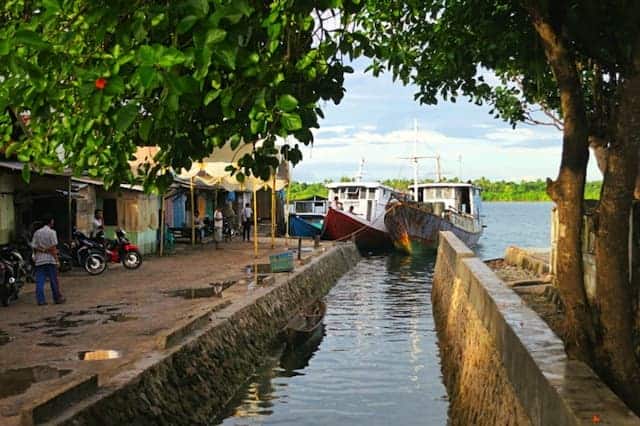Disclaimer: This post contains affiliate links to handpicked partners, including tours, gear and booking sites. If you click through or buy something via one of them, I may receive a small commission. This is at no extra cost to you and allows this site to keep running.
Wakatobi Island in Indonesia is seen as the Indonesian equivalent of Mauritius or the Seychelles with added mystique. Here’s how to find it.
Wakatobi island in Indonesia; the name sounds mystical with a little whiff of the Orient. It definitely sounds more enticing than the sum of its constituent parts; Wangiwangi, Kaledupa, Tomia and Binongko. The names of the four islands hardly roll off the tongue.
However, that is largely beside the point, because you could call the islands Hull, Limerick, Detroit and Moskova and people would still want to come here. It’s the Wakatobi dive resort islands and world-class diving spots, unspoilt coral reefs and miles of golden sandy beaches that attract the tourists.

Wakatobi Island, Indonesia: An Adventure to Paradise
If I had to compare Wakatobi to anywhere else in the world, I would say that it is the Indonesian equivalent of Mauritius or Seychelles with a certain kind of mystique attached to it. The Wakatobi islands have captured a spot in the popular imagination as some kind of ecological tropical paradise and exclusive escape.
This guest post is from Nico, writer of the former blog, A Traveller’s Journey, who lives in Indonesia, splitting his time between his home city of Yogyakarta and far-flung travel destinations like the islands of Wakatobi.
Contents
Getting to Wakatobi Indonesia
The title of ecological paradise is a well-earned one. Wakatobi is located in the Coral Triangle and offers some of the best diving in the world. Meanwhile, the sense of exclusivity attached to Wakatobi is partly explained by just how isolated the islands are – you can fly here, but plane tickets are expensive. At the same time, Indonesian ferries are renowned for ending their journey at the bottom of the ocean, meaning that most tourists opt for a beach holiday in Bali or Lombok.
After a night spent sleeping on a wafer-thin plastic mattress on a hot and overcrowded local ferry, I was beginning to think that a holiday in Bali would have been the better option. I had woken up with a stiff body, a heavy head and a desperate need for a shower. With no solution to hand, I decided to head to the prow of the ship. My heavy head disappeared as I watched the sunrise over an ocean as flat as a millpond, but the space people gave me reminded me that I still needed a shower. Unfortunately, it would be another four hours and two boat trips before I would arrive at the dive resort that I had booked myself into.
What Wakatobi Islands to Visit
Wakatobi is formed of four islands. The island furthest away from Sulawesi is Binongko, after which comes Tomia, then Kaledupa and finally Wangiwangi, which is the most populous and least touristic of all the islands.
Tomia
Tomia remains the most popular island in Wakatobi for divers, securing its titles because of its world-class underwater world that complements the pristine white sand beaches. There are around 40 dive sites in Tomia such as Mari Mabuk, Roma, Ali Reef and the Wreak of Kulati.
Wangiwangi
We arrived in Wangiwangi at 8 am and my first impression of the island was not a good one. Wanci, the capital city of Wakatobi, is more like a regional backwater than a tropical paradise. The city hugs the coastline like a snake. Squat concrete single-story buildings sit next to ramshackle shacks with corrugated iron roofs and wooden walls. A commercial port takes up most of the cities waterfront, while the beaches that are left were littered with plastic bags, empty water bottles and other household trash. I wasn’t in the mood to explore Wanci, so grabbed a motorbike taxi and headed along the city’s sole thoroughfare to the smaller port that connected Wangiwagi to the other islands of Wakatobi.
Kaledupa
On the daily ferry to Hoga, just off the coast of Kaledupa, I spent the time in a hot sticky daze on the roof of the ferry wishing that the time would fly by. After what felt like an eternity, the engines of the boat rumbled to life and with it came a relaxing cool breeze. I slept through most of the journey, catching the occasional glimpse of the still ocean or a passing boat. The idea of Wakatobi being some kind of tropical paradise was slowly sinking, like my mood.
The last stop before Hoga was a floating village in the middle of the ocean constructed on long wooden poles. From here, we would catch the small three-man canoe, which had come to pick us up from the resort. By this point in the day, I was feeling the opposite of the holiday mood. However, the view of Hoga was about to change all of this.
A person from the resort was already waiting at the dock when we arrived. I piled my stuff into the rickety canoe and prepared myself for the last journey of the day. As the boat cut through the waves circling the headland, the resort came into view; five wooden cabins perched on edge of the beach surrounded by coconut trees. The waters surrounding the island were teeming with fish of all types and colours. The accommodation was simple, and the food delicious.
The crystal clear blue ocean, the clean sandy beaches, and the hot sun directly overhead; this was what I had in mind when I set off to find paradise.
If your idea of an ideal holiday is relaxing in a hammock and enjoying nature, then Wakatobi could be your own Indonesia island paradise.
Travelling Southeast Asia?
Travelling beyond Indonesia? Check out my other travel tips and destination insights on other Southeast Asia countries.





Leave a Reply